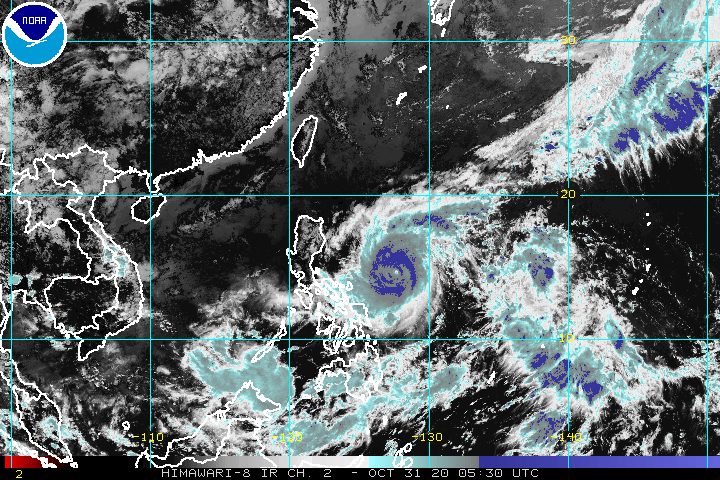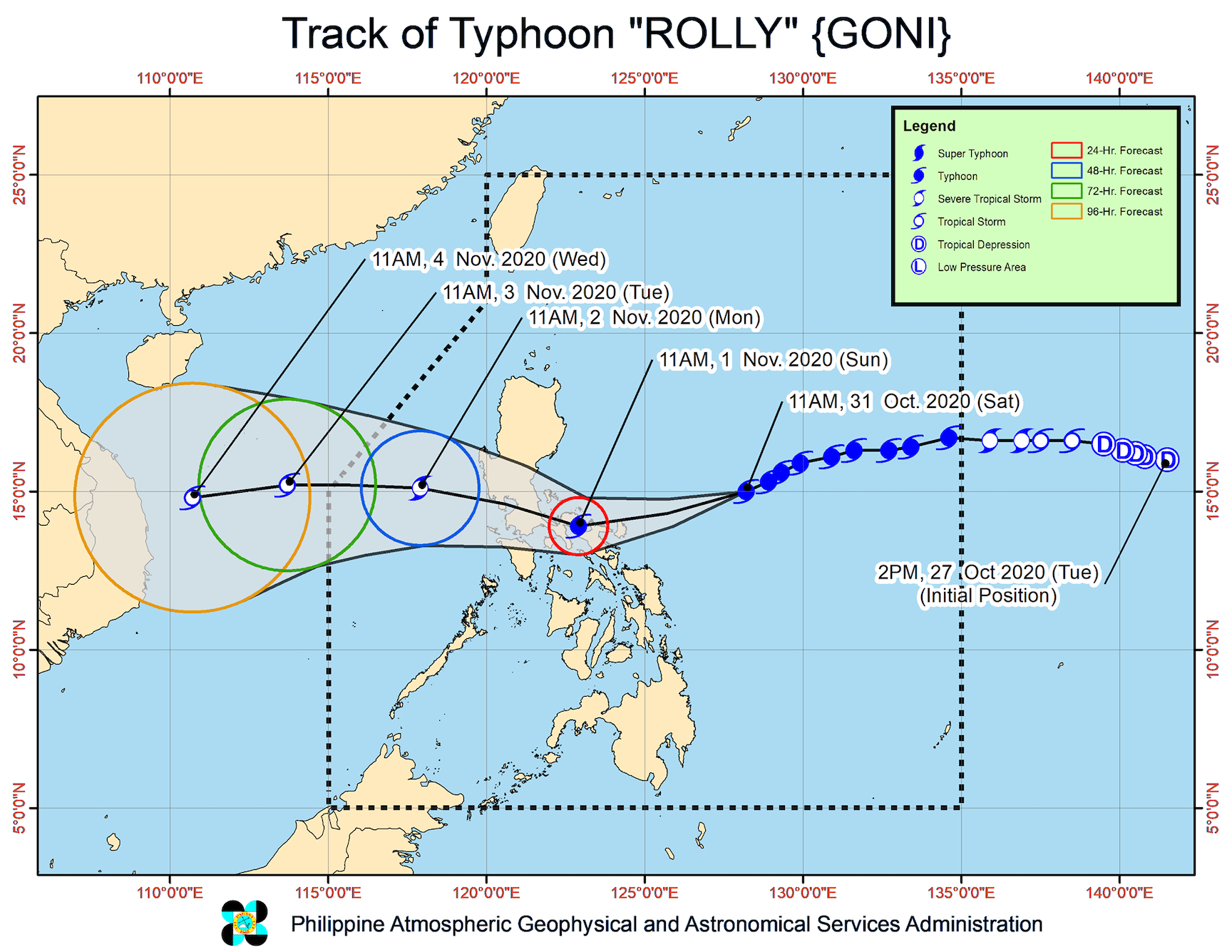SUMMARY
This is AI generated summarization, which may have errors. For context, always refer to the full article.

More parts of Bicol were told to brace for destructive winds from Typhoon Rolly (Goni), which is still heading for the region.
In its 2 pm bulletin on Saturday, October 31, the Philippine Atmospheric, Geophysical, and Astronomical Services Administration (PAGASA) said Rolly is now 410 kilometers east northeast of Virac, Catanduanes.
The typhoon slightly slowed down, moving west southwest over the Philippine Sea at 15 kilometers per hour (km/h) from the previous 20 km/h.
Rolly’s maximum sustained winds remain at 215 km/h, with gustiness of up to 265 km/h. It is currently almost a super typhoon, which PAGASA classifies as having maximum sustained winds exceeding 220 km/h.
PAGASA said Rolly is likely to remain a typhoon, with maximum sustained winds of 185 to 205 km/h, by the time it makes landfall. (READ: FAST FACTS: Tropical cyclones, rainfall advisories)
These are the areas under tropical cyclone wind signals as of 2 pm on Saturday:
Signal No. 3
- Catanduanes
- northeastern part of Camarines Sur (Tinambac, Siruma, Goa, Tigaon, Sagñay, San Jose, Lagonoy, Garchitorena, Presentacion, Caramoan)
- northeastern part of Albay (Tiwi, Malinao, Tabaco City, Malilipot, Santo Domingo, Bacacay, Rapu-Rapu)
Signal No. 2
- southeastern part of Laguna (Santa Maria, Famy, Mabitac, Pakil, Siniloan, Pangil, Paete, Kalayaan, Lumban, Cavinti, Pagsanjan, Luisiana, Majayjay, Magdalena, Santa Cruz, Pila, Liliw, Nagcarlan, Rizal, Victoria, Calauan, San Pablo City, Alaminos, Bay)
- Quezon including Polillo Island
- Camarines Norte
- rest of Camarines Sur
- rest of Albay
- Sorsogon
- northern part of Masbate (Mobo, Milagros, Masbate City, Baleno, Aroroy, Mandaon, Balud) including Ticao and Burias Islands
- Marinduque
- Romblon
- Northern Samar
Signal No. 1
- rest of Masbate
- Rizal
- rest of Laguna
- Cavite
- Batangas
- Occidental Mindoro including Lubang Island
- Oriental Mindoro
- Metro Manila
- Bulacan
- Pampanga
- Bataan
- Zambales
- Tarlac
- Nueva Ecija
- Aurora
- Pangasinan
- La Union
- Benguet
- Ifugao
- Nueva Vizcaya
- Quirino
- southern part of Isabela (Aurora, Luna, Reina Mercedes, Naguilian, Benito Soliven, San Mariano, Palanan, Dinapigue, San Guillermo, Echague, San Agustin, Jones, Cordon, Santiago City, Ramon, San Isidro, Angadanan, Alicia, Cauayan City, Cabatuan, San Mateo)
- northern part of Samar (Tagapul-an, Almagro, Santo Niño, Tarangnan, Catbalogan City, Calbayog City, Santa Margarita, Gandara, Pagsanghan, San Jorge, Jiabong, Motiong, Paranas, San Jose de Buan, Matuguinao)
- northern part of Eastern Samar (Taft, Can-avid, Dolores, Maslog, Jipapad, Arteche, Oras, San Policarpo)
- Biliran
PAGASA warned that destructive typhoon-force winds will be experienced in areas under Signal No. 3, damaging gale- to storm-force winds in areas under Signal No. 2, and strong breeze to near gale conditions in areas under Signal No. 1.
Signal No. 4 remains the highest possible tropical cyclone wind signal that may be raised, for very destructive typhoon-force winds.
PAGASA added that strong breeze to near gale conditions due to the northeasterlies will persist in Batanes, Babuyan Islands, Ilocos Norte, Apayao, and the coastal and mountainous areas of Cagayan and Isabela that are not under a tropical cyclone wind signal.
As for rainfall, PAGASA again updated its outlook, now forecasting that Rolly’s outer rainbands will be felt on Saturday.
Light to moderate rain, with at times heavy rain
- Bicol
- Eastern Visayas
Beginning early Sunday morning, November 1, the passage of the typhoon will trigger serious rain. Floods and landslides could occur.
Heavy to intense rain
- Metro Manila
- Bicol
- Calabarzon
- Central Luzon
- Marinduque
- northern parts of Occidental Mindoro and Oriental Mindoro
Moderate to heavy rain
- Cagayan Valley
- Cordillera Administrative Region
- Ilocos Region
- Romblon
- rest of Occidental Mindoro and of Oriental Mindoro
Rolly’s track
PAGASA said the center of the eye of the typhoon is forecast to pass over the Catanduanes-mainland Camarines area on Sunday morning, and over mainland Quezon on Sunday afternoon.
“Violent winds and intense rainfall” from Rolly’s inner rainband-eyewall region will be experienced in Catanduanes, Camarines Norte, and Camarines Sur from early Sunday morning to afternoon, and over Quezon and the southern part of Aurora from Sunday afternoon to evening.
Rolly is now also projected to cross the Southern Luzon-Metro Manila area. Afterwards, it could exit mainland Luzon landmass on Monday morning, November 2, possibly emerging as a severe tropical storm or “minimal” typhoon over the West Philippine Sea.
PAGASA explained that while crossing Luzon, Rolly is forecast to “weaken considerably.”
Coastal conditions
PAGASA also warned that there is now a high risk of storm surges in the next 24 hours, “which may result in life-threatening and damaging coastal inundation.” Storm surges could be “accompanied by swells and breaking waves reaching the coast.”
- northern coastal areas of Quezon including Polillo Island, Camarines Norte, Camarines Sur, Catanduanes – more than 3 meters high
- coastal areas of Manila, Cavite, Bulacan, Pampanga, Bataan; southeastern coastal area of Batangas; southwestern coastal area of Quezon – 2.1 to 3 meters high
- coastal areas of Aurora, Zambales, Occidental Mindoro; rest of the coastal areas of Bicol, Batangas, Quezon – 1 to 2 meters high
Travel is also risky for all types of vessels in:
- seaboards of areas under Signal Nos. 1, 2, and 3 – rough to phenomenal seas, with waves 2.5 to 15 meters high
- remaining seaboards of Northern Luzon as well as eastern seaboards of Eastern Visayas that are not under a tropical cyclone wind signal and Caraga – rough to very rough seas, with waves 2.5 to 5 meters high
In the remaining seaboards of the country, there are moderate to rough seas, with waves 1.2 to 2.5 meters high. PAGASA advised those using small vessels to take precautionary measures, while “inexperienced mariners should avoid navigating in these conditions.”
Rolly could leave the Philippine Area of Responsibility (PAR) on Tuesday morning, November 3.

Aside from Rolly, PAGASA continues to keep an eye on Tropical Depression Atsani, which was 1,655 kilometers east of Southern Luzon as of Saturday morning.
The tropical depression is moving west northwest at 25 km/h and may enter PAR on Sunday afternoon.
Once Atsani enters, it will be given the local name Siony. (READ: LIST: PAGASA’s names for tropical cyclones in 2020)
This means there would be two tropical cyclones inside PAR at the same time, though PAGASA said Atsani “remains less likely to affect any portion of the country over the next 2 to 3 days.”
Atsani had maximum sustained winds of 55 km/h and gustiness of up to 70 km/h as of late Saturday morning. But it is likely to reintensify into a tropical storm in the next 24 hours.
Rolly is the Philippines’ 18th tropical cyclone for 2020, while Siony would be the 19th. Rolly is also the 5th tropical cyclone for October alone.
An average of 20 tropical cyclones form within or enter PAR each year.
These are PAGASA’s latest estimates for the number of tropical cyclones inside PAR in the next 6 months:
- November 2020 – 1 to 3
- December 2020 – 2 or 3
- January 2021 – 0 or 1
- February 2021 – 0 or 1
- March 2021 – 0 or 1
- April 2021 – 0 or 1
Last October 2, the state weather bureau warned Filipinos to expect more rain in the coming months due to the onset of La Niña. – Rappler.com
Add a comment
How does this make you feel?




There are no comments yet. Add your comment to start the conversation.